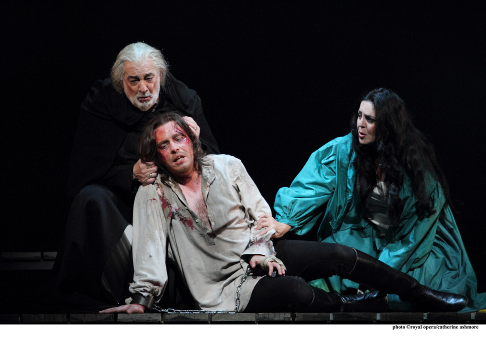First, Pl·cido Domingo is an icon. Even past his prime, he has such presence that he can present a role with style. When he does retire, we can look back and say we were there. Secondly, Francesco Foscari is a role that doesn’t present extreme vocal demands. Domingo didn’t go much out of range. Foscari is an old man, worn out by tragedy and the intrigues of state. Sounding pinched and dry is part of the character.
Domingo knows how to marshal his reserves. At the end, the old man rages against the city and the fates that have destroyed him. Mellifluous sounds would be inappropriate. Domingo sings with such intensity that it feels like a statement. We shouldn’t shaft old Doges because they aren’t what they were, any more than we should shaft Father Figures like Pl·cido Domingo. The Council of Ten might be ungrateful, but I, for one, treasured his performance.
 Pl·cido Domingo as Francesco Foscari, Francesco Meli as Jacopo Foscari and Maria Agresta as Lucrezia Contarini
Pl·cido Domingo as Francesco Foscari, Francesco Meli as Jacopo Foscari and Maria Agresta as Lucrezia Contarini
Domingo’s presence in Los Angeles honours the city, just as a great Doge would have honoured Venice. That’s perhaps why the Royal Opera House brought this production to London, so we could enjoy Domingo once again in a role he can still achieve reasonably well. The narrative is bleak and sombre. There aren’t all that many flashy “big moments” for Antonio Pappano to whip the orchestra into full Verdian glory. The set (designs by Kevin Knight, with costumes by Mattie Ulrich) thus serve to distract from the opera itself. We delight in the gorgeous jewel colours that show Venice at its gaudy best. But the gem is flawed. The city is rent by vicious intrigue. The Doge is destroyed in a way that would hurt the most: his last son is accused, exiled and dies. It’s not a pretty story. Still, we can fantasize, like the crowds in the piazza watching the circus acrobats and fire-eaters doing their tricks. What a brilliant metaphor! Even at this early age, was Verdi making oblique statements?
Wonderful atmospheric lighting by Bruno Poet, whose lighting suggests mists descending on the city, enveloping it in gloom. Most of the effects are created by video projections. so the set travels well. Just as the invention of electric light changed opera, video allows infinitely greater possibilities than, say, painted flats. The art comes in using technique well. Here, though, we see a backdrop of waves, which might have been exciting in Los Angeles, but London audiences would recognize as the backdrop to Birtwistle’s The Minotaur. Numerous other projections onto cloth, which seem to be done by fairly basic oil and water washes projected onto cloth. The giant face of the Lion of Venice doesn’t do as it’s told. Maybe there’s a very subtle truth in that but the production isn’t quite that deep. The projections dissolve as the cloth is lowered, clumsily, into a hole in the floor. Apart from the nice costumes, the production feels minor house. Thaddeus Strassberger, an American, is director, but there’s not much direction as such. The singers strike am-dram theatrical poses, but since the production revolves entirely around Pl·cido Domingo, there’s probably little need to develop the other roles as drama.
Vocally, Maria Agresta’s Lucrezia Contarini. was the high point of the evening. What a pure, clean voice, capable of passionate conviction. Agresta and Francesco Meli, who sings Jacopo Foscari, provided the vocal colour otherwise in short supply, in an opera that depicts a harsh, repressive regime. When Agresta and Meli sang their final duet, the opera came to life. That said, though, Maurizio Muraro, singing Jacopo Loredano, member of the Council of Ten, impressed with the authoritative richness in his voice. The other members of the Council, and the rows of women in white, priests, servants and so on, operate anonymously, which is perhaps right, but Muraro’s Loredano has power and individuality. So, yes, go to this I due Foscari, for Pl·cido Domingo, around whom it’s all been created.
For more information please see the Royal Opera House site.
Anne Ozorio
image=http://www.operatoday.com/2677ashm_1664%20copy%20DOMINGO%20AS%20FRANCESCO%20FOSCARI%20%28C%29%20ROH.%20PHOTOGRAPHER%20CATHERINE%20ASHMORE.png
image_description=Pl·cido Domingo as Francesco Foscari [Photo (C) Roh. Photographer Catherine Ashmore]
product=yes
product_title=Pl·cido Domingo: I due Foscari, London
product_by=A review by Anne Ozorio
product_id=Above: Pl·cido Domingo as Francesco Foscari
Photos © ROH. Photographer: Catherine Ashmore.